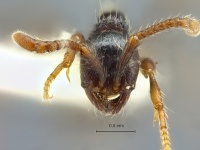Aenictus sulawesiensis
| Aenictus sulawesiensis | |
|---|---|

| |
| Scientific classification | |
| Kingdom: | Animalia |
| Phylum: | Arthropoda |
| Class: | Insecta |
| Order: | Hymenoptera |
| Family: | Formicidae |
| Subfamily: | Dorylinae |
| Genus: | Aenictus |
| Species: | A. sulawesiensis |
| Binomial name | |
| Aenictus sulawesiensis Jaitrong & Wiwatwitaya, 2013 | |
So far A. sulawesiensis has been known only from the type locality.
Identification
A member of the pachycerus group. This species is very similar to Aenictus kutai (see under A. kutai).
Keys including this Species
Distribution
Sulawesi
Latitudinal Distribution Pattern
Latitudinal Range: -4.5° to -4.5°.
| North Temperate |
North Subtropical |
Tropical | South Subtropical |
South Temperate |
- Source: AntMaps
Distribution based on Regional Taxon Lists
Indo-Australian Region: Indonesia (type locality).
Distribution based on AntMaps
Distribution based on AntWeb specimens
Check data from AntWeb
Countries Occupied
| Number of countries occupied by this species based on AntWiki Regional Taxon Lists. In general, fewer countries occupied indicates a narrower range, while more countries indicates a more widespread species. |

|
Estimated Abundance
| Relative abundance based on number of AntMaps records per species (this species within the purple bar). Fewer records (to the left) indicates a less abundant/encountered species while more records (to the right) indicates more abundant/encountered species. |

|
Biology
Castes
Known only from the worker caste.

| |
| . | |
Nomenclature
The following information is derived from Barry Bolton's Online Catalogue of the Ants of the World.
- sulawesiensis. Aenictus sulawesiensis Jaitrong & Wiwatwitaya, 2013: 100, fig. 2A-C (w.) INDONESIA (Sulawesi).
- Type-material: holotype worker, 67 paratype workers.
- Type-locality: holotype Indonesia: S Sulawesi, Barru, Taneterilau, Lipukasi, Forest omplex Coppo, (4°30’S, 119°37’E), 8.i.2011, CE11-SKY-21 (Sk. Yamane); paratypes with same data.
- Type-depositories: MZBJ (holotype); BMNH, FFKT, MCZC, MHNG, MZBJ, SKYC, TNHM (paratypes).
- Distribution: Indonesia (Sulawesi).
Unless otherwise noted the text for the remainder of this section is reported from the publication that includes the original description.
Description
Worker
Holotype: TL 3.25 mm; HL 0.76 mm; HW 0.65 mm; SL 0.63 mm; ML 1.05 mm; PL 0.29 mm, CI 85; SI 96.
Paratypes (n = 9): TL 3.25-3.30 mm; HL 0.75-0.78 mm; HW 0.63-0.65 mm; SL 0.60-0.63 mm; ML 1.04-1.06 mm; PL 0.28-0.30 mm, CI 82-85; SI 96-98.
Head in full-face view elliptical, distinctly longer than broad, with feebly convex sides; posterior margin convex; occipital margin bearing a narrow collar. Antennal scape relatively short, extending beyond 2/3 of head length, but not reaching posterolateral corner of head; antennal segment II slightly shorter than broad; III–VII each almost as long as broad; terminal segment almost as long as VII+VIII+IX. Frontal carinae well developed, fused at the level of antennal base to form a single carina, extending less than half length of head; posterior half of frontal carina very poorly developed, with head in profile roundly concave. Parafrontal ridge well developed, reaching 1/3 of head length (0.30 mm); seen in profile, its anteriormost part well developed and subtriangular, and posterior part feebly convex. Masticatory margin of mandible with large apical tooth followed by a medium-sized subapical tooth and 5–6 denticles; basal margin lacking denticles. Mesosoma elongate and stout; promesonotum seen in profile slightly convex dorsally, sloping gradually to metanotal groove; mesopleuron not clearly demarcated from metapleuron; metanotal groove indistinct; propodeum in profile lower than promesonotum, nearly straight dorsally; propodeal junction angulate; declivity of propodeum shallowly concave, encircled with a rim. Petiole subsessile, almost as long as high, its node short and elevated posteriorly; subpetiolar process weakly developed or almost absent, its ventral margin feebly convex. Postpetiole almost as long as petiole, dorsally convex.
Dorsum of head punctate; lateral face with weaker punctuation (reticulate with smooth and shiny bottoms) than dorsum and partly smooth and shiny or superficially reticulate with smooth interspaces. Antennal scape microreticulate. Mandible entirely micropunctate except for apical tooth and along masticatory margin. Greater part of pronotum superficially sculptured or smooth and shiny. Petiole entirely punctate and opaque; postpetiole entirely punctate except small area on dorsum shiny. First gastral tergite and sternites smooth and shiny except for the basalmost part with dense punctures. Basal half of femora microreticulate, but apical half superficially macroreticulate, smooth and shiny, partly superficially shagreened with smooth and shiny interspaces. Tibiae microreticulate, somewhat shiny.
Head and mesosoma dorsally with dense standing hairs; longest pronotal hair 0.23-0.25 mm long. Dorsum of head, mandible and mesosoma dark brown; legs, waist, and gaster dark reddish brown to reddish brown; antennal scape dark brown except for apicalmost portion reddish brown; all funicular segments reddish brown. Typhlatta spot absent
Type Material
Holotype worker from Indonesia, S. Sulawesi, Barru, Taneterilau, Lipukasi, Forest Complex Coppo (4°30'S, 119°37'E), 8 Jan.2011, coll. Sk. Yamane, CE11-SKY-21 (Bogor Zoological Museum). Sixty-seven paratype workers, same data as holotype (Ant Museum, The Natural History Museum, Museum of Comparative Zoology, Musee d'Histoire Naturelle Genève, Bogor Zoological Museum, SKY Collection, Natural History Museum of the National Science Museum).
Etymology
The specific name is derived from name of the type locality, Sulawesi Island of Indonesia.
References
References based on Global Ant Biodiversity Informatics
- Borowiec M. L. 2016. Generic revision of the ant subfamily Dorylinae (Hymenoptera, Formicidae). ZooKeys 608: 1–280.
- Jaitron W., and D. Wiwatwitaya. 2013. Two new species of the Aenictus pachycerus species group (Hymenoptera: Formicidae: Aenictinae) from southeast Asia. The Raffles Bulletin of Zoology 61(1): 97-102.

